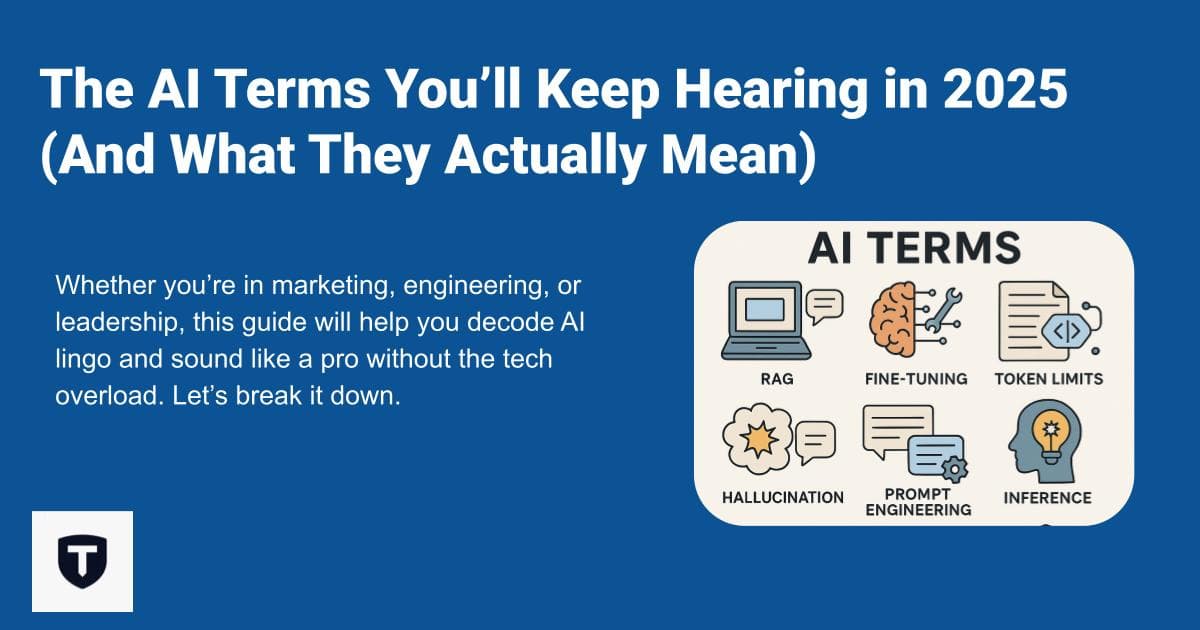AI is everywhere in 2025, and so is its jargon. From boardrooms to dev teams, terms like “RAG,” “fine-tuning,” and “embedding” get tossed around like confetti—but what do they really mean? At TopCompany.ai, we’ve cut through the buzzwords to create a plain-English glossary for cross-functional teams. Whether you’re in marketing, engineering, or leadership, this guide will help you decode AI lingo and sound like a pro without the tech overload. Let’s break it down.
Why This Glossary Matters
AI terms can feel like a secret code, alienating non-technical team members or muddying strategic decisions. Our definitions are grounded in real-world use cases, informed by vendor documentation (e.g., x.ai, openai.com), industry standards from thoughtspot.com, and X posts as of May 2025. We focus on terms you’ll hear in meetings, pitches, and product docs, making them clear for everyone from analysts to CEOs.
Key AI Terms for 2025
1. RAG (Retrieval-Augmented Generation)
What It Means: A way to make AI smarter by combining its language skills with fresh, external data. Think of it as an AI that can Google relevant info before answering your question.
Why It Matters: RAG helps tools like Grok (xAI) or Perplexity give accurate, up-to-date answers by pulling from databases or the web, reducing errors or “hallucinations” (made-up facts).
Example: Ask Grok about recent X posts, and RAG fetches real-time data to keep the answer current (x.ai).
2. Fine-Tuning
What It Means: Tweaking a pre-built AI model with your own data to make it better at specific tasks, like writing in your brand’s voice or analyzing legal contracts.
Why It Matters: Fine-tuning saves time and boosts performance. It’s why Claude can be customized for creative writing or ChatGPT for customer support scripts.
Example: A marketing team fine-tunes Jasper.ai to churn out Instagram captions that match their quirky tone (jasper.ai).
3. Token Limits
What It Means: The maximum number of words (or pieces of words) an AI can process in one go. Tokens are like the AI’s “attention span” for inputs and outputs.
Why It Matters: Hit the token limit, and your AI might cut off mid-sentence. Tools like OpenAI’s GPT or Anthropic’s Claude list token limits to help you plan prompts.
Example: ChatGPT’s 4,096-token limit means it can handle a few pages of text but might struggle with a whole book in one shot (openai.com).
4. Embedding
What It Means: A fancy way of saying “turning words, images, or data into numbers” that an AI can understand. It’s like translating your content into AI’s native language.
Why It Matters: Embeddings power search, recommendations, and clustering. Tools like Pinecone or Grok use embeddings to find relevant documents or suggest similar ideas.
Example: Grok’s enterprise search uses embeddings to match your query to the right internal docs, even if the wording differs (x.ai).
5. Hallucination
What It Means: When an AI confidently spits out wrong or made-up info, like claiming the moon is made of cheese.
Why It Matters: Hallucinations undermine trust. Tools like Claude prioritize low hallucination rates, while others may need fact-checking.
Example: Ask a poorly trained AI about 2025 events, and it might invent a fictional tech conference. Claude’s design minimizes this risk (anthropic.com).
Learn more about AI Hallucination.
6. Prompt Engineering
What It Means: Crafting clear, specific instructions to get the best results from an AI. It’s like giving a chef a detailed recipe instead of saying “make something tasty.”
Why It Matters: Good prompts save time and reduce errors. It’s a skill for using tools like ChatGPT, Grok, or Perplexity effectively.
Example: Instead of “Write a blog,” a prompt like “Write a 500-word blog on AI trends for small businesses, with a friendly tone” gets better results (openai.com, x.ai).
7. Inference
What It Means: The process of an AI generating answers or predictions using a trained model. It’s the “thinking” phase after the model’s been built.
Why It Matters: Faster inference means quicker responses. Tools like Perplexity optimize inference for real-time web answers.
Example: When Grok answers your question about X trends, inference is what churns through its model to deliver the reply (x.ai).
8. Context Window
What It Means: The amount of text or data an AI can “remember” at once while processing your request. It’s like the AI’s short-term memory.
Why It Matters: A larger context window (e.g., Claude’s 200,000 tokens) lets the AI handle longer conversations or documents without forgetting details.
Example: Fireflies.ai uses a big context window to summarize hour-long meetings without losing key points (fireflies.ai).
9. Multimodal AI
What It Means: An AI that can handle multiple types of data—like text, images, or audio—in one go. It’s the Swiss Army knife of AI.
Why It Matters: Multimodal tools like Grok (with image analysis) or ChatGPT (text and visuals) are versatile for creative or complex tasks.
Example: Upload a chart to Grok and ask for insights—it’ll “read” the image and respond with analysis (x.ai).
10. API (Application Programming Interface)
What It Means: A way for developers to plug an AI’s powers into their own apps or systems, like adding Grok’s search to a company dashboard.
Why It Matters: APIs make AI scalable. Companies use OpenAI’s API or xAI’s API to build custom tools or automate workflows.
Example: A retailer uses OpenAI’s API to power a chatbot that answers customer queries on their website (openai.com/api, x.ai/api).
How We Built This Glossary
- Real-World Focus: We picked terms based on 2025’s hottest AI trends, seen in X posts, vendor blogs (x.ai, anthropic.com), and platforms like intellipaat.com.
- Plain English: Definitions avoid jargon to help non-techies, inspired by userinterviews.com feedback.
- Credible Sources: We cross-checked with industry leaders like OpenAI, Anthropic, and xAI, ensuring accuracy as of May 2025.
Limitations
- Evolving Terms: AI lingo shifts fast. Check vendor sites (x.ai, openai.com) for the latest definitions.
- Scope: We cover mainstream terms, not niche ones like “quantization” or “pruning.”
- Context: Some terms (e.g., RAG) vary slightly by tool, so test in your use case.
Keep learning about the future of AI here.


